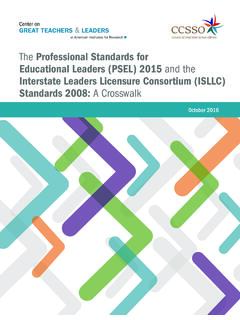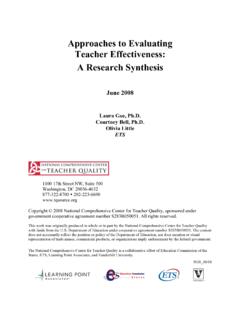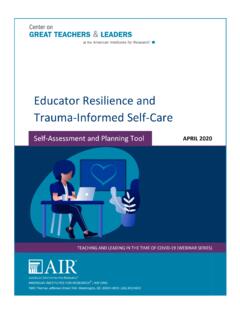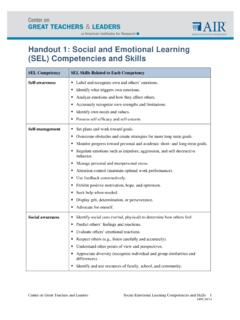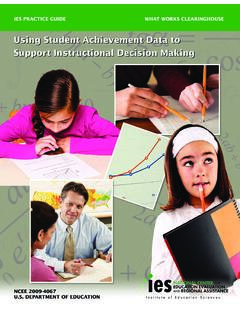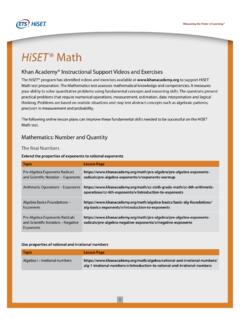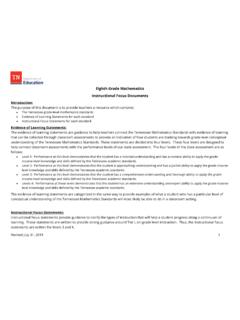Transcription of Teaching the Whole Child - Center on Great Teachers & …
1 Research-to-Practice BriefJANUARY 2014 Teaching the Whole ChildInstructional Practices That support Social-Emotional Learning in Three Teacher Evaluation FrameworksCenter on Great Teachers & LEADERS at American Institutes for Research ACKNOWLEDGMENTSThe author would like to thank Angela Minnici, Jenny Scala, Ellen Cushing, and Catherine Jacques for their input on drafting the brief, as well as their review and revisions. The author would also like to thank the following for their helpful reviews of the manuscript: David Osher, Tori Cirks, Greta Colombi, Jenni Fetters, Joyce Harris, Kathryn Broullire, and Vickie BriefTeaching the Whole ChildInstructional Practices That support Social-Emotional Learning in Three Teacher Evaluation FrameworksRevised Edition JANUARY 2014 Nicholas Yoder, 1 Introduction 2 Understanding Social-Emotional Learning 2 What Is Social-Emotional Learning?
2 5 Why Is Social-Emotional Learning Important? 6 Supporting Social-Emotional Learning: Action Steps for Policymakers and Educators 10 Teaching Practices That Promote Students Social-Emotional Competencies 19 Using Teacher Evaluation Systems to support SEL: Professional Teaching Frameworks 21 Locating SEL in Teacher Evaluation: A Crosswalk Between the 10 SEL Teaching Practices and Three Common Professional Teaching Frameworks 25 Action Steps for States 28 References 30 Appendix A. Social-Emotional Learning Programs/Scholars and Related Practices 35 Appendix B. Full References for Reviewed Scholars and Social-Emotional Learning Programs 1 Teaching the Whole Child instructional Practices That support SEL in Three Teacher Evaluation FrameworksIntroductionEducators, policymakers, and researchers agree that Teachers have a significant impact on student learning (Chetty, Friedman, & Rockoff, 2011; Nye, Konstantopoulos, & Hedges, 2004).
3 They also know that effective Teachers do more than promote academic learning they teach the Whole Child . Teachers help promote the social and emotional learning skills students need to be college and career ready, such as collaborating with others, monitoring their own behavior, and making responsible decisions. Social-emotional learning is critical to the introduction of college and career readiness standards, which increase the demands on students ability to engage in deeper learning and shift the focus and rigor of instruction (National Governors Association Center for Best Practices [NGA Center ] & Council of Chief State School Officers [CCSSO], 2010a; NGA Center & CCSSO, 2010b).To bridge the connection between social-emotional learning and the work that educators are already doing, educators need access to tools, supports, and resources on social-emotional learning that are integrated into existing teacher evaluation and professional development systems.
4 Not only does this reinforce the importance of social-emotional learning, it avoids overburdening educators by layering on yet another separate initiative. Ensuring that our teacher evaluation systems privilege and reinforce the successful Teaching of these competencies is, therefore, of critical importance As a school committed to developing social/emotional competencies in children as part of a wider school climate improvement process, we have adopted SEL standards, developed an SEL curriculum, included various accountability measures in teacher evaluations to ensure consistency and authentic delivery schoolwide. In order for these approaches to be successful, it has been essential for us to provide adequate professional development and coaching for our Teachers to ensure buy-in, depth of understanding, and breadth of knowledge.
5 Vanessa Camilleri, Director of Student support Services, The Arts & Technology Academy Public Charter School Teaching the Whole Child instructional Practices That support SEL in Three Teacher Evaluation Frameworks 2To aid this critical work, this Research-to-Practice Brief aims to do the following:1. Identify the Teaching practices that promote student social-emotional learning, which in turn are critical for student academic Showcase how three popular professional Teaching frameworks embed practices that influence not only student academic learning but also student social and emotional brief begins by providing a definition of social-emotional learning and a discussion of why it is important.
6 Understanding Social-Emotional Learning What Is Social-Emotional Learning?Social-emotional learning (SEL) is the process of developing students social-emotional competencies that is, the knowledge, skills, attitudes, and behaviors that individuals need to make successful choices (Collaborative for Academic, Social, and Emotional Learning [CASEL], 2003). SEL promotes activities that develop children s ability to recognize and manage emotions, build relationships, solve interpersonal problems, and make effective and ethical decisions (Payton et al., 2000). Developing social and emotional skills is even more critical for students living in underresourced areas, both urban and rural. Students in urban areas and/or areas that are underresourced are surrounded by added stressors that make it difficult for them to learn.
7 When students develop social-emotional competencies, they are more capable of seeking help when needed, managing their own emotions, and problem-solving difficult situations (Romasz, Kantor, & Elias, 2004).According to CASEL ( -and-emotional-learning/core-competencie s), there are five core social-emotional competencies, each KEY DEFINITIONS Social-emotional learning is the educational process that focuses on development of social-emotional competencies. Social-emotional competencies are the skills, behaviors, and attitudes students and adults need to effectively manage their affective, cognitive, and social behavior. Safe and supportive learning environments are the conditions that foster safety; a supportive academic, disciplinary, and physical environment; and respectful, trusting, and caring relationships throughout the school community.
8 Professional Teaching frameworks define common components of Teachers professional practice, which reflect multiple levels of teacher performance. 3 Teaching the Whole Child instructional Practices That support SEL in Three Teacher Evaluation Frameworksaddressing multiple skills that students need to be successful in school and their future careers. The five overarching competencies are as follows (see Table 1 for a list of skills related to each competency): Self-awareness is the ability to recognize one s own feelings, interests, and strengths, in addition to maintaining an accurate level of self-efficacy. Students who are self-aware are capable of describing and understanding their own emotions.
9 In addition, they are capable of recognizing their own strengths and weaknesses (Payton et al., 2000). Students beliefs about their own strengths and weaknesses influence the academic choices they make, how long they will persist on tasks (Zimmerman, 2000), and whether or not they will ask for help on academic tasks (Ryan, Gheen, & Midgley, 1998). Self-management skills allow individuals to handle daily stresses and control their emotions under difficult situations. Students capacities to regulate their emotions impact student memory and the cognitive resources they use on academic tasks (Gross, 2002). Self-management skills include the ability to monitor and reflect on personal and academic goal-setting.
10 Academic self-regulation has important implications for student motivation in the classroom, as well as the learning strategies students use to master material (Clearly & Zimmerman, 2004). Social awareness allows individuals to take others perspectives into account and to empathize with others. Socially aware students are more likely to recognize and appreciate the similarities and differences of others. Social awareness is particularly important for students as they participate in new instructional shifts. Students need to take the perspectives of their classmates during classroom discussions and attempt to empathize and relate with characters during analysis of texts. Relationship management allows students to develop and maintain healthy relationships with others, including the ability to resist negative social pressures, resolve interpersonal conflict, and seek help when needed.


